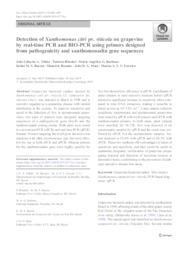Detection of Xanthomonas citri pv. viticola on grapevine by real-time PCR and BIO-PCR using primers designed from pathogenicity and xanthomonadin gene sequences.
Detection of Xanthomonas citri pv. viticola on grapevine by real-time PCR and BIO-PCR using primers designed from pathogenicity and xanthomonadin gene sequences.
Author(s): VILLELA, J. G. A.; RITSCHEL, P. S.; BARBOSA, M. A. G.; BACCIN, J. M. S.; ROSSATO, M.; MAIA, J. D. G.; FERREIRA, M. A. S. V.
Summary: Grapevine bacterial canker caused by Xanthomonas citri pv. viticola (X. campestris pv. viticola) (Xcv), was detected in Brazil in 1998 and is currently regarded as a quarantine disease with limited distribution in the country. To improve sensitivity and speed in the detection of Xcv in asymptomatic grapevines, two pairs of primers were designed, targeting sequences of a pathogenicity gene (hrpB) and the xanthomonadin coding cluster. Both pairs were tested in conventional PCR (cPCR) and real-time PCR (qPCR) formats. Primers targeting the hrpB gene showed cross reactions with other Xanthomonas spp. but were effective for use in both cPCR and qPCR, whereas primers for the xanthomonadin gene were highly specific for Xcv but showed low efficiency in qPCR. Enrichment of plant extracts in semi-selective medium before qPCR allowed a significant increase in sensitivity when compared to total DNA extraction, making it possible to detect as low as 101 CFU ml-1. Under natural infection conditions, symptomatic and asymptomatic grapevines were tested by qPCR with hrpB primers and cPCR with xanthomonadin primers. In both cases, plant extracts were enriched for 36-72h. Xcv was detected in all symptomatic samples by qPCR and the result was confirmed by cPCR. For the asymptomatic samples, Xcv was detected in 93.4% with qPCR and in 89.5% with cPCR. These two methods offer advantages in terms of sensitivity and specificity, and they could be useful in quarantine programs, certification of grapevine propagating material and detection of inoculum sources in alternative hosts, contributing to the prevention of pathogen spread to disease-free areas.
Publication year: 2019
Types of publication: Journal article
Unit: Embrapa Grape & Wine
Observation
Some of Embrapa's publications are published as ePub files. To read them, use or download one of the following free software options to your computer or mobile device. Android: Google Play Books; IOS: iBooks; Windows and Linux: Calibre.
Access other publications
Access the Agricultural Research Database (BDPA) to consult Embrapa's full library collection and records.
Visit Embrapa Bookstore to purchase books and other publications sold by Embrapa.

